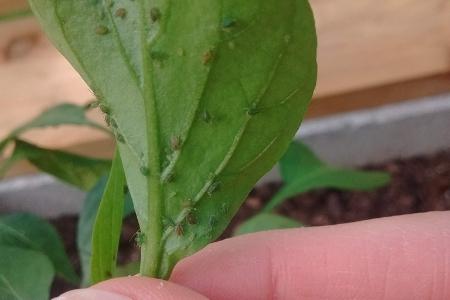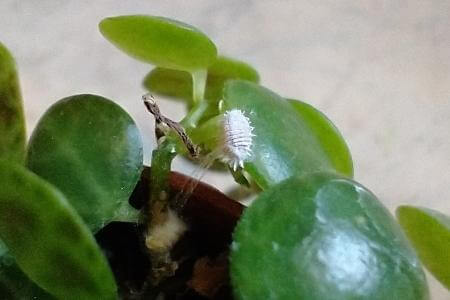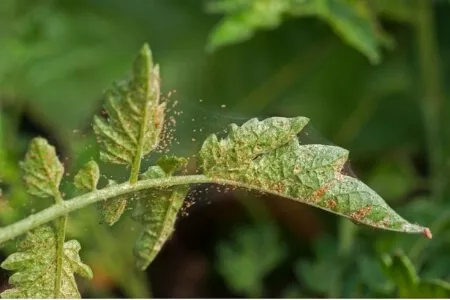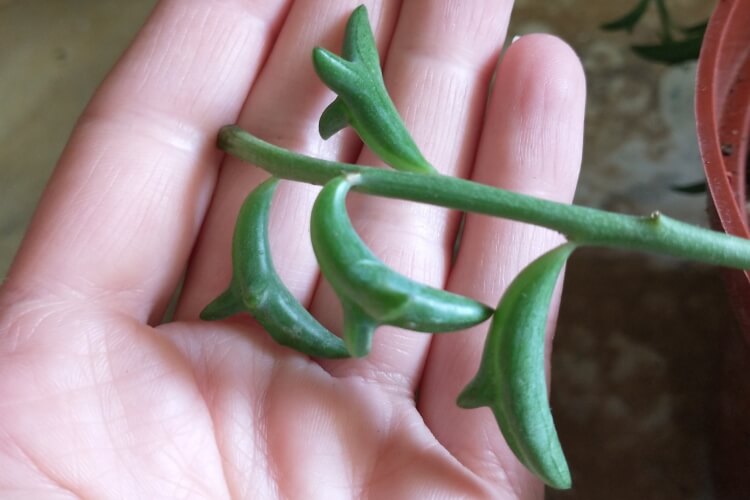You’ve probably heard of the string of pearls, string of hearts, string of turtles, string of bananas, string of tears… But have you ever heard of string of dolphins? If you love succulents, trailing plants and dolphins, it’s a must-have!
String of dolphins is a hybrid of string of pearls and candle plant, and it gets its name from the distinctive bluish-green leaves that are shaped like dolphins in mid-jump. String of dolphins is a fast-growing, trailing succulent with tendrils that can reach up to 3 feet long, and it’s often displayed in hanging baskets or spilling over the edge of a shelf.
In this article, you’ll learn the background information about this interesting plant and how to keep it happy and healthy in your home. You’ll also find out how to troubleshoot potential problems and the answers to some common questions.
Let’s dive in (just like a dolphin!)
Plant Type: | Succulent |
Native Habitat: | Central and South America |
Botanical Name: | Dendrophorbium peregrinum |
Growth Pattern: | Trailing |
Watering: | When soil is dry several inches deep |
Light: | Bright, indirect light |
Soil: | Well-draining potting soil |
Temperature: | 65-75 degrees F |
Humidity: | Tolerates average room humidity |
Potential Problems: | Overwatering, misshapen leaves, pests |
Repotting: | Every 3 years, in the spring |
Table of Contents
String of Dolphins Background
String of dolphins is a hybrid plant, meaning that it was created by human plant breeders and is not found in nature. One parent plant, the string of pearls, originates in South Africa, and the other parent, the candle plant, hails from Central and South America.
It’s a member of the large and diverse Asteraceae family, which also includes daisies, zinnias, lettuces and dandelions. There is conflicting information about the exact scientific name, but most authoritative sources list string of dolphins as Dendrophorbium peregrinum. Other names you may see listed for this plant include Curio x peregrinus (which are the two parent plants) and Senecio peregrinus.
String of dolphins goes by a few different common names, including these:
- Dolphin string
- Dolphin plant
- Dolphin necklace
- Flying dolphins (my personal favorite!)
It’s pretty easy to see where the plant gets its name- each leaf looks surprisingly like an actual dolphin jumping out of the water:

String of Dolphins Care
String of dolphins plant care is quite similar to other succulents, but even I can find that tricky to figure out sometimes. No worries-your dolphin plant is considered even beginner safe!
Here’s everything you need to know about maximizing your plants care and growth.
Appropriate Pot Size and Type
First off, you’ll need the right pot to house your dolphin plant.
Terra cotta, clay or cement are the most ideal pot materials since their porous nature allows for good air flow and letting excess moisture escape. Plastic and glazed ceramic can also work, but you’ll have to be more vigilant in your watering routine.
Whatever pot material you choose, make sure it has well-defined bottom drainage. This is the key to watering appropriately and avoiding problems like root rot.
Pot size is usually a little larger than the current pot the string of dolphins is in, no more than an inch wider in diameter. As long as you meet these requirements, you can hang it up or place it on a bookshelf and let it trail down the shelves. Just be sure to use a plant saucer to catch drainage.
Light-Textured Soil
String of dolphins like well draining soil with light texture. As a succulent, the plant’s native habitat is in dry, harsh climates, and the chunky leaves store water for the future. So the soil shouldn’t retain lots of moisture- that can just damage the roots.
Vladan Nikolic, founder of Mr. Houseplant, shares his insights on whether your run-of-the-mill houseplant soil will work here. “Don’t use a potting mix straight out of a bag. Most of them retain too much water and aren’t good for the roots.”
But you can work with regular houseplant soil to make it hospitable to your dolphin plant. Vladan continues, “Amend whichever potting mix you buy with coarse perlite, pumice, bark, or another amendment. Use 2 parts potting mix, 1 part perlite or another amendment. This will make the potting mix have more oxygen which is very important for the roots, it will make the potting mix dry faster and reduce the chances of overwatering.”
There are also quite a few commercial succulent soil mixes you could buy. I put all my succulents in Espoma Cactus Mix, and I’ve always been happy with the results.
Lighting Requirements
String of dolphins prefers bright, indirect sunlight. Place it in a east or south facing window where it can get sunlight for 6 or more hours per day.
Don’t have a sunny windowsill? Consider a grow light!
Watering
String of dolphins watering is similar to most succulent care.
Allow the soil to dry out through most of the pot before soaking it again- it should feel dry to the touch several inches deep before you add any more water.

Ambient Temperature
String of dolphins plant prefers temperatures between 65 and 75 degrees Fahrenheit, and 72 degrees seems to be their perfect temp (much like myself!).
It’s not frost-hardy, and USDA zone 10 or higher is its native habitat. But it can tolerate cooler temperatures as low as 40 degrees F for a short period.
Humidity
The average home humidity is acceptable to this dolphin plant, and a drier environment is ideal. If you have other succulents or cacti in your collection, a string of dolphins is a perfect companion.
Most succulents thrive in low humidity and can develop fungal spots if there’s too much moisture on their leaf surface. So do not mist your string of dolphins, and keep it out of rooms that have naturally high humidity, like a bathroom.
Fertilizing
String of dolphins typically doesn’t require any fertilizing, especially if you’re using good quality succulent or potting soil. In fact, over fertilizing can result in the leaves losing their dolphin shape.
If you’d like to encourage a little extra growth, you can give a dose of fertilizer once in the spring to get your plant ready for the active growing season. If you do decide to fertilize, dilute the formula to half strength and be sure to give a good watering along with the fertilizer to help flush out any excess.
Pruning
Pruning is not usually necessary for string of dolphins, but you can snip off any yellow or brown leaves. You can trim back the vines by a few inches and replant the trimmings in the soil to make it look fuller. You can also use these trimmings to propagate more strings of dolphins!
Dormancy
From late spring or early summer through late fall, string of dolphins is considered active. The time from early winter through spring is string of dolphins’ dormancy period, or a seasonal resting phase where the plant doesn’t produce new growth.
Since the activity slows down in dormancy, your plant processes water much more slowly as well. Reduce watering frequency by about half during this time.
Tips for Getting Sting of Dolphins to Flower
Not only is this uniquely shaped succulent easy to grow, but under the right circumstances, it will even bloom!

A mature string of dolphins will produce clusters of small white flowers that smell like cinnamon in the spring and summer. There are a few steps you can take during the dormant months to encourage flowering the next season:
- Keep your string of dolphins at about 60 degrees Fahrenheit
- Water only when completely dry
- Make sure it’s in a small pot to keep the roots compact
- Keep your plant in a location that gets gentle indirect light for a few hours each day
What you’re trying to accomplish here is duplicating the environmental conditions of the plant’s native habitat. Hopefully, you’ll enjoy some lovely and fragrant blossoms as the reward of your labor in just a few months!
Repotting String of Dolphins
String of dolphins likes to be a bit root-bound, so repotting is not needed very often at all- maybe once every three years.
Since string of dolphins has a shallow root system, you typically won’t see the tell-tale sign of root tips poking out from the bottom of a too-small pot. Instead, be on the lookout for these signs:
- Your plant’s growth has slowed down significantly
- The soil dries out much faster than it used to
- You can’t remember when you last repotted or it’s been a couple of years since you got the plant
When it’s time to repot, be sure to pick a pot that’s only about 1 inch larger in diameter than the current pot and has bottom drainage holes.
Then follow these steps:
- Water your string of dolphins the day before repotting for ease of removing the root ball from the old pot.
- Tilt the pot sideways and tap to carefully remove your string of dolphins.
- Tease the root ball slightly with your fingers and detangle it to encourage growth. While you’re doing this, take a close look at the roots. Use sanitized scissors to cut out any dark or soft roots.
- Add soil to the new pot and place your string of dolphins on top.
- Fill in around the root ball with fresh potting or succulent soil.
- Wait to water for a few days, especially if you had to cut any root tips. This gives your plant a chance to form a protective callous against infection at the cut points.
RELATED: For another trailing succulent that truly looks just like its namesake, learn how to care for string of turtles. It’s an adorable plant!
Potential Problems with String of Dolphins
There aren’t too many potential problems to worry about with your string of dolphins, but you may run into a few issues from time to time. Here are some tips for remedying problems as well as prevention:
Root Rot
Root rot can be a problem with any potted plant, especially when your pot doesn’t have sufficient drainage or the soil doesn’t facilitate drainage.
If your string of dolphins develops root rot, remove it from the pot and cut out the damaged roots. Allow the root system to dry out completely before repotting in a clean pot with good drainage and fresh arid soil.
Then water again only when the soil is completely dry.
Misshapen Leaves
When string of dolphins’ leaves become misshapen, it could be due to a few issues:
- Watering- either too much or too little
- Reverting to one of the parent plants’ shape
- Not enough light
- Too much fertilizer
Here’s what might happen in each of these situations.
Watering. If the leaves appear shrunken or shriveled, your plant is likely in need of water. Give a good thorough watering, and make sure to check the soil moisture more frequently going forward.
If the dolphins are swollen and losing their shape, there’s too much water and your plant needs to dry out. Hold off on watering for several days, and make sure nothing is obstructing the bottom drainage holes.
Reverting. String of dolphins is a hybrid, or a cross between two other plants. In some cases, string of dolphins can start to show more of the characteristics of one of the parent plants instead of the unique mix it should have.
This video from Pleasant Prickles talks about this very issue, which she suspects may have started with a heavy pruning she did. It’s a pretty interesting thought!
If your plant has indeed reverted, there’s not much you can do except provide the best care you can and hope for the dolphins to return. Otherwise, just try to enjoy your plant the way it is!
Lighting. As also pointed out in the video above, sometimes a string of dolphins can take on a flattened leaf shape if it’s not getting enough light. Move your plant to a sunny location, but make sure to keep it out of harsh, direct light.
Over Fertilizing. In overly rich soil conditions, your plant’s leaves may lose their distinctive “dolphin fins.”
If you suspect you’ve over-fertilized, flush any remaining fertilizer from the soil by repeatedly drenching the soil, about 3-4 times. Let your plant dry out, and don’t give more fertilizer in the future.
Hopefully, your dolphins will regain their normal shape in time!
Pests
String of dolphins can be affected by common houseplant pests like aphids, mealybugs, spider mites and scale insects.




If you see pests on your plant, remove as many as possible by spraying your plant off in the shower or with a garden hose. I’ve also had great success with wiping pests away with a cotton swab or ball dipped in alcohol.
After physically removing the pests, spray your plant with insecticidal soap. And check back on your plant several times in the next few days- pests love to hide and you’ll probably find more after the initial treatment. Keep removing them and using the insecticidal soap until you haven’t seen any more bugs for a few days.
The best way to prevent these pests is by checking your new string of dolphins (or any houseplant!) before you bring it home. If you spot any signs of pests, treat the plants in a separate room before putting it near other houseplants.
Leggy Growth
Leggy growth is usually due to low levels of sunlight. Ensure your string of dolphins is receiving at least 6 hours of bright, indirect sunlight daily to encourage healthy foliage and growth.
One problem you may run into is the top of the plant losing leaves and starting to look a bit sparse. This often happens from overwatering and a lack of good airflow to the plant. Try scaling back on watering, and always try to water the actual soil without splashing the leaves.
Fungal Diseases
Like other succulents, string of dolphins is built for drier climates and does not readily absorb moisture through its leaves. This means that if you allow water to sit on the leaf surfaces, it can form mold or mildew spots.
If you notice any leaves with brown or black spots, it’s probably a fungal growth. Remove the leaves and discard them. In the future, try watering less often and avoid getting water on the leaves.
If needed, try watering your plants from the bottom rather than the top. Fill a container that’s larger than your pot with a few inches of tepid water, then set the entire pot into the container. The soil will absorb moisture through the pot’s drainage holes.
Leave the pot in the water for about 15 minutes, then remove it and set it on a shallow dish to catch any drips. After about 30 minutes to 1 hour, place your string of dolphins back in its normal spot.
Where to Buy String of Dolphins
When you’re ready to buy your first string of dolphins, you’ve got many options to choose from. I’ve occasionally seen a string of dolphins at my local garden center, but finding one in person is always quite hit-or-miss.
Fortunately, there are several online sources to get a healthy plant:
- Plants for Pets on Amazon. A portion of your purchase will also help shelter animals!
- Succulents Store on Etsy
- Dose of Succulents on Etsy
- Desert View Cactus on Etsy
Propagating String of Dolphins
Plant propagation means to grow new plants from sections of an existing one, and you can multiply your collection of string of dolphins from stem cuttings.
I’ve covered the entire process in detail and with lots of photos in our guide to propagating string of dolphins, but here’s a quick overview.
You can propagate your stem cutting either in soil or water, and you’ll need just a few supplies:
- Clean gardening shears or sharp scissors
- For water propagation: a clean jar and filtered water
- For soil propagation: A small pot made of plastic, terra cotta, or clay with a bottom drainage hole, succulent soil and (optional) rooting hormone or honey
Once you’ve prepared all of the supplies, cut a strand 3-5 inches long. Remove the lowest 2-3 leaves and allow the cut end to dry for 2 days.
For water propagation, place your cutting in the jar of water, making sure to submerge the area where you removed the leaves. Place in a sunny window, and replace the water weekly or sooner if it starts to look cloudy. Roots should emerge in 1-2 weeks.
For soil propagation, dip the end of the cutting in rooting hormone or honey, if desired. Then insert the cutting end into the succulent soil or lay it on the soil surface. Place in a sunny window and keep the soil lightly moist. Roots should sprout in 2-3 weeks.

Frequently Asked Questions about String of Dolphins
Final Thoughts
String of dolphins is such an easy plant to care for, and the dolphin-shaped leaves would suit any beach-loving plantophile. It’s a beautiful vining succulent, great for hanging baskets or a hanging pot where it can trail with abandon.
Really, there’s no reason not to have one!
We want to hear from you! Are there any other questions you have about string of dolphins or how to care for one? Do you have one of these plants and have some care tips you’ve discovered? Your questions or experience may be exactly what someone else needs to hear, so please feel free to share in the comments!

